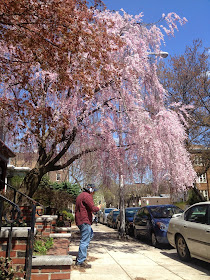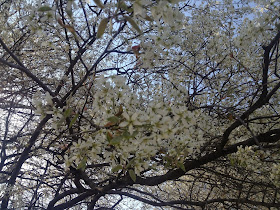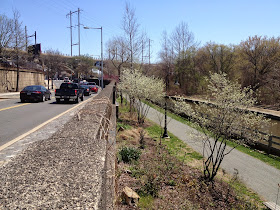People
are always asking me: Hey, Jon Spruce,
enjoying the weather?
It
sure is pretty to think so.
In
all actuality, this is my busy season, not much time to enjoy the weather. This is the time of year when I need to rise
up the ranks, get my name out there as a contender for champion tree-hunter.
Spring? That’s when I can really make my bones.
And
it all comes down to flowers.
Funny,
isn’t it?
Years
and years of steady watching, months and months of mindful observations, miles
and miles under my feet and on my car and yet my whole reputation rests on
those bright, brief modified leaves we call flowers.
It’s
almost too much for one set of eyes but, contrary to popular belief, you don’t
have to do it alone.
Like
the old folk song says, help is on the
way.
And
the best help this time of year?
That’d
be the truckers.
That’s
right. The biggest help at this time of
year is usually found high up in the cabs behind the big wheels of all those
trucks making traffic here in the city.
I’m
talking about Bakemark and Aramark, Samuels & Sons and J. Ambrogi, Cintas
Uniforms and W.B. Mason, plus all the other gypsy pilots navigating the Philly
grid and barreling down the highways.
Best
set of eyes in the entire city.
There
we go.
All
set now.
This
morning, I dug out my old short-wave radio and, using a bit of good old
fashioned Yankee know-how, I added a state-of-the-arts wireless antenna, hooked
it up to these new-fangled Bluetooth headphones…
…and
then plugged in the two-way microphone.
Okay,
all I got to do now is find the right station, adjust the squelch and speak
clearly into the mike.
Jon
Spruce is back on the CB.
Breaker,
breaker, this is Jon Spruce over here in Phillytown. Need some assistance, boys. Who’s out there?
The
next part is easy.
Just
lean in and try to catch some chatter on the only free press left in the United
States of America: the citizen’s band radio.
Spruce, you old
scallywag. Is that really you?
Shiver
me timbers, that voice is a real blast from the past. That’s Goldberg, my old co-pilot. I didn’t know he was in town.
Alive and
kicking, Spruce. Surprised to hear you
too. I always pictured you still keeled
over in El Paso.
El
Paso? Oh man, I spent a bad week there
one night. Goldberg always did have a
long memory.
Hard to forget,
Jonny boy. What’s your emergency?
Need some
flowers for the blog, chief. What are
you seeing out there?
You’re a lucky son of a gun, always have been, Spruce. I just passed some willows blazing away in Penn Park by the river.
Willows? Goldberg always did have a soft spot for
willows but I don’t know. I’ve already
covered the willow. I need flowers, not willows.
Quit your
griping, Spruce, and get down to the river before it’s too late. You’ll thank me later.
…thank
you, Goldberg.
These
are some fine willows and I’d never been to this park before.
Twenty-four
acres big, Penn Park is a fairly new landscape here in Philadelphia and,
walking its grounds on the beginning of a very blue spring day, it’s easy to
pick out the willow as its most dominant tree.
It
probably has something to do with drainage.
The willow is an excellent tree to help control the high groundwater
found in parks close to the river.
It’s
a tree that flourishes in the mire, a tree that does its best rooted in soggy
grass.
I’m
sure the Penn landscapers knew something about this when selecting the trees.
Thoreau
was a big willow-watcher, always marking its catkins as the first sign of
spring. The yellow willow catkins pushing out, he wrote in his journal, begin to give the trees a misty, downy
appearance, dimming them.
I
see what he means now. At this time of
year, there seems to be a fuzzy, yellow halo hovering above each willow.
From
this distance, their crowns shine and glow but step closer…
…and
then the top of each tree, like Thoreau once noticed, blends impossibly into
the blue sky…
…dimming them.
I
step even closer to the slender branches, which in the wicker industry are called
withies…
…and
from somewhere deep inside my inner ear, I hear the lyrics of another folk
song…
…the wind in the willows playing tea for two,
the sky was yellow and the sun was blue.
I
see what that means now. Standing in the
wind, under the spring willow, the sun is clearly, undeniably blue.
On
my way home, another voice broke through the CB static.
Breaker,
breaker, did I hear Jon Spruce on this dial or are my rusty ears playing tricks
again? You out there, Spruce?
It
was my old partner-in-crime, J-Rose. I
haven’t talked to him in years.
Ha, I knew it
was you. Jon Spruce bending the needle,
it’s been a long time coming. Wait till
I tell old Bessie.
Oh
my, that brings back some good memories.
Bessie used to be our first baseman in our old softball league but it
was her bat that took us all the way to the Kansas City Intramural Classic. Her stance alone used to bring the whole
outfield in.
Like
Bob Dylan once said, she had the biggest
boat that I’ve ever seen.
J-Rose, you tell
sweet Bessie that I’ll look her up next time I’m passing through Wichita. Right now, I need some flowers for the blog. What’s your ten-twenty?
You want
flowers, Spruce-man? Get your lazy butt
down to South Philly. The pears are shooting
stars over here.
Pear
trees? I’ve already done pear trees. Is anybody reading this blog?
People are
really talking about them.
Of
course they are, J-Rose.
People
are always talking about the callery pears but it’s usually a series of ten-ones.
That’s
CB for poor reception.
Regardless of
cultivar, wrote
the University of Connecticut, Pyrus
calleryana is wholly overused in the landscape, leading to monotony and
boredom.
That’s
a true story but I don’t blame the pear.
It’s
not that it’s a bad tree. It’s not that
it doesn’t belong anywhere in our city, in our woods or in our hearts.
Actually,
it’s our fault. We put it in the wrong
place. We cast it in the wrong
role.
The
pear has no business being a street tree.
It
has too many distinct characteristics that are now considered disadvantageous
to its current role: prone to blight, weak branching structure, dangerously
tottering limbs over our cars…
…and,
worst of all, over-planted and overused.
But
it’s hard to get anybody to listen to these complaints on days like this.
They
were planted for days like this…
…even
though days like this don’t last forever.
Enjoying the
view, Spruce?
Hard not to.
You got a real
pretty city here, Philly boy.
That’s a 10-4,
good buddy, but please don’t tell me you sent me all the way to South Philly to
catch a pear. What else you got?
Ah, I’m headed
to the highway now, got to drag this wagon back to Norfolk before dark but I’ll
tell you what. Go down to Marconi Park
and send me a picture of that elm.
Here
you go, J-Rose.
I
actually almost missed it. At first
glance, I thought this was an oak. It
has a very stout and wide trunk and I’m used to elm-trunks being taller and thinner but then I saw that distinct ropy bark…
…and
then I noticed that typical splash of branches…
…and
finally I looked up to catch those clusters of young, flaky emeralds of fruit.
Now
that’s an elm.
Surprised
to see fruit?
Don’t
be.
Some trees are done flowering,
already on a stampede towards fruit.
That brutal winter, this late spring and this recent batch of hot sun
and clear skies? That's a recipe for fruit.
If you're not quick enough, you can miss the spring all together.
It’s
tricky, to catch a tree in season. It
takes talent and it takes marksmanship and it takes more luck than I’d like to
admit.
For
most trees.
There
are a few trees out there that bloom like clockwork, as reliable as the
calendar, as dependable as old friends.
And
no other tree illustrates this thought better than the amelanchier…
…a
tree that flies into spring the same week as Easter, which is why most people
call it the serviceberry…
…although
some sources say the name serviceberry
has a different connotation. Some say that the service
refers to funerals since its flowering meant that the ground was finally
thawed, time to dig the graves for the souls lost to winter.
The
Cree Indians called it the saskatoon. The tree was so prevalent in their country,
delighting the banks of their creeks, that the largest city in the prairie
province of Saskatchewan took the name as its own.
It’s
a member of the Rose family and, like all Rose trees, it has a five-petal
flower.
...with enough room in between flowers to let in a lot more of that blue, blue sun.
It’s hard to believe but this little tree actually has more names.
It’s
also called the juneberry and, in
just a couple months, it will produce a dark purple berry about the size of
a pea, famous among the wildlife and foragers for its cherry-like flavors.
According
to Thoreau, around Cape Cod, the berries were also called the josh-pears which, he figures, was a
corruption of the word juicy.
But
by far, my favorite name for this tree has got to be the shadbush, so named because its flowering is perfectly timed to the
great shad migration…
…which
is why my favorite shadbush in the entire city is the small grove planted right
along the Manayunk towpath between Main Street and the Schuylkill River.
It’s
something quite near perfect to catch the flowering shadbush next to a river.
Contrary
to popular belief, seafood is also meant to be seasonal and, in this part of
Turtle Island, the shad was known as one of the first foods of spring.
After
spending its summer in the northern reaches of the Bay of Fundy, the shad will
spend the autumn and winter swimming and feeding down to the Chesapeake Bay.
In
spring, as the shadbush blooms, they migrate back north.
During
this migration, some of the older shads swim up the freshwater rivers to
spawn. The Connecticut, the Hudson, the
Susquehanna, the Delaware and all of their major tributaries, all major routes
of the shad run.
They are so
plentiful,
wrote William Penn in 1686, that Captain
Smyth’s Overseer at the Skulkil drew 600 and odd at one Draught, 300 is no
wonder, 100 familiarly…they are caught by net only.
That
last statement was captured in two paintings by Philadephia's own Thomas Eakins.
So this is spring? By the wings of Wabun, it’s full of wheels.
Natural
or unnatural or supernatural, it all comes down to wheels, wheels within wheels
barreling down the highway of history, nothing standing still for one second.
The
Easter weekend, the great shad run and the flowering of a little tree with too
many names, all passing over at the same time, wheels within wheels.
This
is not a new idea. It never was.
Resurrection,
that’s a wheel. Herring migration? That’s a wheel too. The shadbush
turning into the juneberry, that’s
my favorite wheel of all.
Three
calendar events on the same quick string of time and the ouroboros takes
another small bite of its tail…
…a
circuitous route that almost, just almost, can take us back to the very beginning...
...but I don't know if I even believe in beginnings anymore.
How does that folk song go?
How does that folk song go?
Small wheel
turning by the fire and rod, big wheel turning by the grace of God…
…and every time
that Wheel turn round…
…bound to cover
just a little more ground.
And
then, as if on cue, another voice from the past crackles through the radio.
Breaker,
breaker, thought I heard a ghost on this station. Are you there, Jon Spruce, it’s me, Shelly.
Uh
oh. This could be trouble.
I
owe Shelly a whole bunch of phone calls and fancy dinners, plus one long,
heartfelt explanation.
I
look into the microphone for any sign of trouble but it’s no help. This microphone has the best poker face I’ve
ever met.
Hey, Shelly, Jon
Spruce here. You got me.
I
hear her lips breaking into a smile.
I was just
thinking about you, girl, thinking about all those evenings we spent wasting
away the morning.
She
swallows a sigh and laughs into the mike.
Jon Spruce, you always did tell
the sweetest lies.
I
still got it, boys.
Shelly, if you
got time to park your wheels, I know a noodle shop in Chinatown that’s always
empty.
No time,
tree-boy. I’m over at the stadium
dropping off my load for the Flyers game, then hauling this big rig deadhead
back to Bismark. Got to hit the road.
Some other time
then.
You still need
some flowers for the blog?
I’ll take what
you got.
Then take your
lying eyes over to Morris Park. Lot of
chatter about the bloodroot over there.
Morris
Park? That’s off City Avenue, in the
middle of the Overbrook neighborhood, right near the city limits on the
outskirts of town.
As
far as native landscapes go, it’s one of the best kept secrets here in the city.
That’s
where the two branches of the Indian Creek flow together…
…eventually
becoming the Cobbs Creek that marks this western boundary of Philadelphia.
It’s full of beech and sycamore, ash and
hickory, tulip poplar and spicebush…
…the
sun-dappled tangles of lesser celandine…
…and
gardens of skunk cabbage…
…and,
oh my god, it’s full of stars.
Meet
the bloodroot, one of our most fleeting and transient, our most wild of the wildflowers…
…one
of our most perfect stars.
It
blooms, on a good year, for a little more than a week…
…and,
even then, you have to catch it at certain hours of a sunny day.
Its
gory name is a translation of Sanguinaria
canadensis, a reference to the red dye found in its roots, used mostly by
the rivercane basketmakers of the Delaware River people.
The
bloodroot only grows along steep and well-drained hillsides…
…under
the crispy carpet of dried beech and oak leaves.
Catch
them while you can…
…although
they are already gone.
Their
blooms begin the spinning of another wheel.
Once
opened to the sun, the bloodroot flower attracts the very first bees and flies
of spring…
…and,
by the end of spring, it folds up into a pod that’s baked in the sun until
it bulges opens with seeds that are carried away by the ants…
…into
the nesting chambers of their subterranean colonies where they use the fleshy
seed-covers as food for their larvae.
Once
the new ants are born, the seeds themselves are left behind, deep in the
ground, to germinate and root again.
On
my way out of Morris Park, I stumbled upon a dead snake...
…fresh
blood on the bloodroot trail.
How
long had it been there? How did it die?
I
do not know how to find these answers.
I
try not to read too much into these things.
I don’t believe in signs, don’t believe in omens, never had much faith
in portents or coincidences. I never saw
an albatross that wasn’t just a big bird.
But
here’s something interesting. In most
cultures, the snake is the symbol for rebirth
and resurrection, something to do
with the shedding of the skin.
For
the Navajo, the snake was a member of the Lightning People Tribe that live in
the clouds. Seeing a snake here on earth meant that rain and thunder was on
the forecast.
In
Philadelphia, a snake means get out of
the woods, there are snakes in these hills.
In
the end, no big deal, just another wheel spinning in spring.
Baby
ants and dead snakes, little creeks and big rivers, new flowers and old friends,
in the end, they’re all just wheels but, man oh man, I really like it when they
give a holler every time they’re passing through.
Like
I said in the morning, it’s all too much for one set of eyes. You’re bound to miss something doing it alone
and there ain’t no shame in asking for directions, ain’t no shame in being
shown the way.
How
does that old folk song go?
Oh
yeah. Every once in a while, you can get
shown the light.
It’s
always in the strangest of places…
…if
you look at it right.
Jon Spruce, over and out.
Jon Spruce, over and out.












































,+Shad+Fishing+at+Gloucester+on+the+Delaware+River+1881.jpg)






























Amen.
ReplyDeleteI absolutely love this post and I guess it is because of all the amazing pictures that you have taken and posted on it this is one of your best posts so keep up the great work !!
ReplyDeleteWhat an engaging read! As someone working in Engineering Services in Karachi, I really appreciate the dedication and attention to detail reflected here — it’s quite similar to what we experience in engineering projects. Whether it’s monitoring systems, ensuring precision, or coordinating with a team (much like those truckers helping out), success often depends on collaboration and timing. Loved the storytelling and the connection between passion, observation, and hard work — values that truly drive both nature lovers and engineers alike!
ReplyDelete